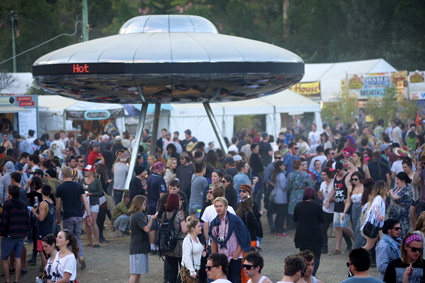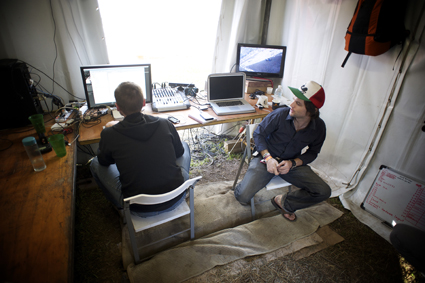cross-disciplinary art rock’n’rolls
jeff khan: splendour in the grass arts program

Splendour in the Grass, Close Encounter, Jordana Maisie
photo Brenden Allen
Splendour in the Grass, Close Encounter, Jordana Maisie
FOR SEVERAL YEARS NOW, ARTIST CRAIG WALSH HAS OVERSEEN AN ARTS PROGRAM AT THE LARGE-SCALE ROCK FESTIVAL SPLENDOUR IN THE GRASS. THE INCLUSION OF CONTEMPORARY ART AT SUCH AN EVENT HAD PREVIOUSLY BEEN SOMETHING OF AN ANOMALY IN THE AUSTRALIAN MUSIC FESTIVAL LANDSCAPE—OR AT LEAST AT THE MORE ROCK’N’ROLL, GEN Y-ORIENTED END OF THE SPECTRUM—SO SPLENDOUR’S INVESTMENT IN THIS AREA IS AN INTRIGUING AND NOTEWORTHY PHENOMENON THAT HAS THUS FAR FLOWN LARGELY UNDER THE RADAR OF MAINSTREAM AUSTRALIAN ART DISCOURSE.
From humble beginnings, the Splendour in the Grass Arts program has continuously expanded, in what seems like an ongoing investigation of just what exactly the possibilities for art might be in this spectacular, pop culture-oriented event. Walsh is an experienced media artist and a leading proponent of the creation of work for non-gallery environments, so he is a fitting choice to head up this project. Particularly interesting amongst these creative possibilities has been the development of the Splendid Arts Lab: a program inaugurated in 2009 and largely funded by the Australia Council’s Opportunities for Young and Emerging Artists initiative, in partnership with Splendour itself and a consortium of regional galleries and organisations situated close to the festival’s original site of Belongil Fields, in the Northern Rivers of New South Wales (the festival has relocated to Woodford, Queensland, for the past two years). In 2009-2011, the Splendid Arts Lab has supported a group of young and emerging artists to attend Splendour in the Grass and a connected art-making laboratory that is designed around the conceit of making a site-specific, interdisciplinary, collaborative work to intervene into this loaded environment. Following the lab and a development period, the artists propose their works to a curatorium, and several works are selected to be made for the following year’s festival.
On paper it seems like a no-brainer, particularly from a funder’s perspective. Gen Y artists, making work for a Gen Y festival, in a groundbreaking, cross-disciplinary style. But the realities of making art for this context are more complex than those tick-boxes would suggest. Firstly, the field of site-specific and socially engaged practice is somewhat under-resourced and underdeveloped in Australia, with few of our major arts institutions supporting the development and presentation of this mode of work. Secondly, as far as situations for site-specific work go, you couldn’t get a site more specific than Splendour in the Grass. A clear-felled, rambling area in the middle of the bush, usually occupied by an annual folk festival, being temporarily overtaken by a massive rock festival, replete with 30,000-odd (mostly white, mostly twentysomething, mostly intoxicated) punters, food stalls, amusements and of course the dozens of bands, DJs and musicians across genres that everyone is there for in the first place.
In short, Splendour is like a mini-city, built around the particular desires of a particular demographic, designed to solicit their interaction, enjoyment and, of course, their cash. Such a setting would be a challenge for any artist to grapple with, and for a young emerging artist who is launching into their practice, the complexities of such a proposition might be especially daunting. Having been employed by Splendid as a Provocateur on the 2010 Lab, I have a particular attachment to these artists and to the developmental process that they undertook. It was encouraging to see them respond to the abovementioned challenges with unflinching rigour, enthusiasm and curiosity. Opportunities to focus on process, and really unpack the complexities around making work—particularly site-specific work—are rare, and so Splendid has provided an important service in this regard. For this year’s festival, three artists from the 2010 Splendid Arts Lab were selected to create work: Jordana Maisie, Jimmy McGilchrist and Matthew Kneale, although Kneale’s performance intervention was unfortunately abandoned due to logistical uncertainties—a real shame considering the rich potential for performance practices in this arena.
Jordana Maisie’s sculpture Close Encounters provided a meeting point at the festival’s Mix Up Stage. Taking the form of a large-scale UFO, its gleaming metallic surface hovering over the crowd, Close Encounters offered an inverted reflection of the ground-level spectacle of the punters themselves. Embedded in its side surface was an LED screen, the kind beloved by lottery kiosks and Jenny Holzer alike. Through an SMS service, festival goers could “talk to the aliens” and have their short-form communiqués broadcast on the screen for all to see. Unsurprisingly, there were a lot of jokes and friends shouting out to other friends, a kind of banal toilet-door-graffiti talk. But these were punctuated by the odd message that was genuinely eccentric or heartfelt. Meanwhile, the artists were concealed behind a nearby fence, sending the punters’ messages to the screen and posting their own replies, presumably from the aliens’ perspective, creating micro dialogues. These text-based interactions were an odd reflection on the ‘heightened’ state of the festival audience, and became mini portraits of the strange modes of socialisation that were taking place around the festival. Despite the technical wizardry, my favourite part of the work was its central shaft—a cylindrical mirrored portal at the centre of the UFO that visually transported punters away from this tangle of crowd and (mis)communication, into the uninterrupted calmness of the sky. A moment of quietness and the sublime amidst the relentless spectacle.

Behind the scenes, Curious Creatures
photo Brendan Allen
Behind the scenes, Curious Creatures
The other work commissioned through the Splendid program was Jimmy McGilchrist’s interactive shadow projection Curious Creatures. Half-concealed up a hillside, people were drawn towards the work by the strange animal-like noises it emanated, and the soft white glow of the projection screens. Across a panoramic screen surface, the shadows of several peculiar, children’s story-book animals roamed a sparse, alien landscape. As viewers approached the screen, their own shadow appeared in the scene and the creatures were drawn to it, running over to interact in vicious, loving, or baffling ways. This deceptively simple effect was in fact a complex programming feat, operated by McGilchrist and his collaborators behind the scenes. Though markedly different in their aesthetic and conceptual strategies, it is interesting to note that both McGilchrist’s and Maisie’s works harnessed digital, interactive technologies to engage the distractible festival-goers, suggesting a potential-laden way of connecting art with a transient crowd such as this.
Beyond the Splendid program, Walsh has been exploring other ways to activate the festival site and its audience through artistic intervention. This year, the Cream program, curated by Annemarie Kohn, brought three artists working with ephemeral, street-based practices together to create temporary interventions into the festival landscape of Splendour. The masking-tape murals of Buff Dis; Oliver in the Sky’s cardboard pop sculptures; and Fernando Llanos’ projections onto a customized blimp provided a counterpoint to Maisie and McGilchrist’s tech- and material-heavy works. Installed responsively throughout the three-day festival, the execution of these temporary works gained an extra performative edge in the heightened but highly contained festival site. Fleet-footed and engaging, the Cream program hinted at exciting approaches yet to come in the Splendour Arts context.
Splendour in the Grass, Splendour Arts program, Woodford, 29-31 July, http://splendourinthegrass.com; Splendid Arts Lab, Lismore and Woodford, www.splendid.org.au
RealTime issue #105 Oct-Nov 2011 pg. 3






